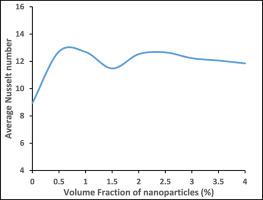Progress in Nuclear Energy ( IF 3.3 ) Pub Date : 2021-01-07 , DOI: 10.1016/j.pnucene.2020.103614 Shahid Husain , Suhail Ahmad Khan , Mohammad Altamush Siddiqui

|
Numerical studies on the effects of volumetric concentration of Al2O3-water nanofluid during low flow rates convection boiling in a vertical annulus is carried out. The aspect ratio of the vertical annulus is 352 while the annular gap is 3.5 mm. The Fluent code is developed using the RPI wall boiling model. The Fluent code is verified with the results available in the literature and also with the results on a similar experimental set-up which shows excellent agreement. The results show that for maximum heat transfer the volumetric concentration of nanoparticles should be 0.5%. It is also inferred that to achieve maximum heat transfer there should be an optimum concentration of nanoparticles. The maximum enhancement in heat transfer coefficient is 42.1%.
中文翻译:

Al 2 O 3-水纳米流体的壁沸腾:纳米颗粒浓度的影响
数值研究了垂直环空中低流量对流沸腾过程中Al 2 O 3-水纳米流体体积浓度的影响。垂直环的纵横比为352,而环形间隙为3.5 mm。Fluent代码是使用RPI壁沸腾模型开发的。可以用文献中提供的结果验证Fluent代码,还可以在相似的实验装置中验证其结果,从而表明一致性。结果表明,为了获得最大的热传递,纳米颗粒的体积浓度应为0.5%。还可以推断出,为了实现最大的热传递,应该有最佳浓度的纳米颗粒。传热系数的最大提高为42.1%。











































 京公网安备 11010802027423号
京公网安备 11010802027423号